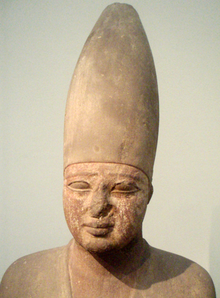Mentuhotep III
| Mentuhotep III | |||||||||||||||||||||||||||||||||||||||||||||||||||||||||||||||||||||||||||||||||||||||||
|---|---|---|---|---|---|---|---|---|---|---|---|---|---|---|---|---|---|---|---|---|---|---|---|---|---|---|---|---|---|---|---|---|---|---|---|---|---|---|---|---|---|---|---|---|---|---|---|---|---|---|---|---|---|---|---|---|---|---|---|---|---|---|---|---|---|---|---|---|---|---|---|---|---|---|---|---|---|---|---|---|---|---|---|---|---|---|---|---|---|
 Osiride statue of the 11th Dynasty pharaoh Mentuhotep III, on display at the Museum of Fine Arts, Boston. | |||||||||||||||||||||||||||||||||||||||||||||||||||||||||||||||||||||||||||||||||||||||||
| Pharaoh | |||||||||||||||||||||||||||||||||||||||||||||||||||||||||||||||||||||||||||||||||||||||||
| Reign | 2009–1997 BC[1] | ||||||||||||||||||||||||||||||||||||||||||||||||||||||||||||||||||||||||||||||||||||||||
| Predecessor | Mentuhotep II | ||||||||||||||||||||||||||||||||||||||||||||||||||||||||||||||||||||||||||||||||||||||||
| Successor | Mentuhotep IV | ||||||||||||||||||||||||||||||||||||||||||||||||||||||||||||||||||||||||||||||||||||||||
| |||||||||||||||||||||||||||||||||||||||||||||||||||||||||||||||||||||||||||||||||||||||||
| Consorts | Imi (?) | ||||||||||||||||||||||||||||||||||||||||||||||||||||||||||||||||||||||||||||||||||||||||
| Mother | Tem | ||||||||||||||||||||||||||||||||||||||||||||||||||||||||||||||||||||||||||||||||||||||||
| Died | 1997 BC | ||||||||||||||||||||||||||||||||||||||||||||||||||||||||||||||||||||||||||||||||||||||||
| Burial | TT281 (uncertain) | ||||||||||||||||||||||||||||||||||||||||||||||||||||||||||||||||||||||||||||||||||||||||
| Dynasty | 11th dynasty | ||||||||||||||||||||||||||||||||||||||||||||||||||||||||||||||||||||||||||||||||||||||||
Sankhkare Mentuhotep III (also Montuhotep III)[5] of the Eleventh Dynasty was Pharaoh of Egypt during the Middle Kingdom. He was assigned a reign of 12 years in the Turin Canon.
Reign
[edit]Mentuhotep III succeeded his father Mentuhotep II[6] to the throne. It is believed that, following his father's long 51 years of reign, Mentuhotep III was relatively old when he acceded to the throne and reigned for 12 years. Despite its short duration, Mentuhotep's reign is known for his expedition to Punt and architectural innovations.
Name
[edit]Mentuhotep III's titulary is very similar to the third and final one of his father. Mentuhotep III is known to have had at least two praenomen: the well known Sankhkare and also
| |
snfr-k3-ra
"He who embellishes the Soul of Re"
Expedition to Punt
[edit]
Mentuhotep III sent an expedition to the Land of Punt during the 8th year of his reign, something that had not been done since the Old Kingdom. An inscription in the Wadi Hammamat describes the expedition as being 3000 men strong and under the command of the steward Henenu. As they left Coptos in direction of the Red Sea (port of Mersa Gawasis?), they dug 12 wells for future expeditions and cleared the region of rebels. They returned from Punt with incense, gum and perfumes, and quarried the Wadi Hammamat for stones.
Monuments
[edit]
Sankhkare Mentuhotep was responsible for several building projects in the 12 years of his reign. He extended the temple of Monthu in Medamud, a monumental decorated doorway bearing his likeness and royal titles now resides in the Louvre.

Sankhkare Mentuhotep also had a mudbrick temple erected at Thoth Hill in Western Thebes. The temple was built on the site of an older archaic temple. It was dedicated to the god Montu-Ra. This temple may have been destroyed by an earthquake towards the end of the 11th Dynasty.[7]
It was long presumed that his own tomb and mortuary temple was begun in Deir el-Bahari, but never completed.[7] This temple was located in a separate valley a short distance from his father's mortuary temple. A causeway would have led up to a temple platform. A burial chamber lined with limestone slabs was completed and sealed, but apparently it never contained a burial. The association of the monument with Sankhkare Mentuhotep was circumstantial, based on co-location with the tomb (TT280) of the High Steward Meketre, one of the chief officials of the reign. However Dorothea Arnold recently provided compelling evidence that the monument is the likely unfinished Theban tomb of Amenemhat I, the funerary monument of Sankhkare Mentuhotep remains unknown.[8] However, the attribution of the monument to Amenemhat I is unproven as well. The owner of the unnamed royal burial place must remain open.[9]
Family
[edit]Mentuhotep III was the son and successor of Mentuhotep II. One of the wives of Mentuhotep II, Tem, was given the title Mother of the Dual King and based on that title she is almost certainly the mother of Mentuhotep III. Mentuhotep III's family is mostly a mystery. It is currently believed that he fathered his successor Mentuhotep IV with one of his harem wives, Imi. This is however still debated[10] Mentuhotep IV's mother is known to have been Queen Imi. If he was the son of Mentuhotep III, Imi must have been the wife of Mentuhotep III.[11]
References
[edit]- ^ Stewart, John (2006). African States and Rulers (Third ed.). London: McFarland. p. 81. ISBN 0-7864-2562-8.
- ^ a b Karl Richard Lepsius: Denkmaller, Abtheilung II Band IV Available online see p. 152 Archived 2015-10-27 at the Wayback Machine
- ^ King List (chronological) Archived 2004-12-24 at the Wayback Machine
- ^ Clayton, Peter A. Chronicle of the Pharaohs: The Reign-by-Reign Record of the Rulers and Dynasties of Ancient Egypt. Thames & Hudson. p72. 2006. ISBN 0-500-28628-0
- ^ Firth, Lesley (editor-in-chief); et al. (1985). "Mentohotep III". Who Were They? The Simon & Schuster Color Illustrated Question & Answer Book. Little Simon Book, Simon & Schuster, Inc., New York City. p. 12. ISBN 0-671-60476-7.
{{cite encyclopedia}}:|author=has generic name (help) - ^ "Mentuhotep III". ib205.tripod.com. 9 December 2012. Archived from the original on 9 December 2012. Retrieved 28 October 2016.
- ^ a b Wilkinson, Richard H., The Complete Temples of Ancient Egypt, Thames and Hudson, 2000,pp. 37, 172, 173, 181, ISBN 0-500-05100-3
- ^ Arnold, Dorothea, "Amenemhat I and the Early Twelfth Dynasty at Thebes": Metropolitan Museum Journal, v. 26 (1991).
- ^ Harco WillemsEgypt's Middle Kingdom: a view from within, in Karen Radner, Nadine Moeller, and D. T. Potts (eds): The Oxford History of the Ancient Near East: Volume II, Oxford, ISBN 9780190687571, 684-687
- ^ Dodson, Aidan and Hilton, Dyan. The Complete Royal Families of Ancient Egypt. Thames & Hudson. 2004. ISBN 0-500-05128-3
- ^ Tyldesley, Joyce. Chronicle of the Queens of Egypt. Thames & Hudson. 2006, pp. 66-68. ISBN 0-500-05145-3
Further reading
[edit]- Grajetzki, W. (2006). The Middle Kingdom of Ancient Egypt: History, Archaeology and Society. London: Duckworth. pp. 23–25. ISBN 0-7156-3435-6.
